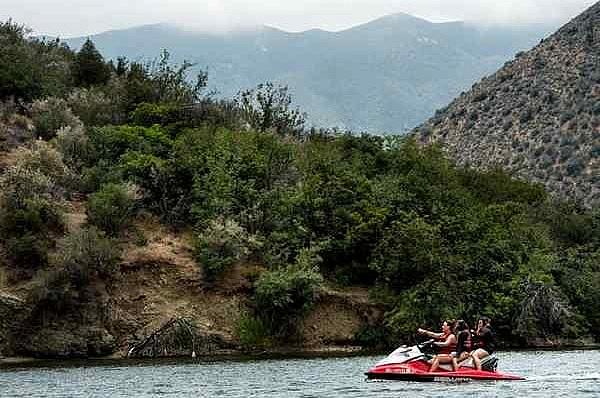Don’t go swimming at Pyramid Lake due to toxic algae bloom, water officials say
This article was produced as a project for the 2015 California Data Fellowship, a program of the Center for Health Journalism at the USC Annenberg School for Communication and Journalism.
Other stories in the series include:
Wading into danger: Growth of toxic algae could make California's lakes unsafe?
What’s being done to assess blue-green algae’s risk to humans
Toxic algae is blooming more often in our lakes, reservoirs. Does that threaten our drinking water?

People ride a jet ski at Pyramid Lake in Lebec, Calif. on Wednesday, June 15, 2016. On Tuesday, the state warned people not to wade, swim or water-ski at the lake because of a large algal bloom that has developed there.
State water officials are urging people to avoid any contact with the water at Pyramid Lake because of a toxic algae bloom that has developed on the Los Angeles County reservoir.
In a statement issued Wednesday, the California Department of Water Resources advised the public to not wade, swim or water-ski at the lake and to keep dogs and children away from the water. Caution signs have also been posted at the lake, according to Ted Thomas, a spokesman for the department.
“Activities near the water such as picnicking and hiking are safe,” the statement read. “Because these blooms can form and die off fairly rapidly, DWR has increased its monitoring of the water quality in Pyramid Lake throughout the summer recreation season and will update this advisory if conditions change.”
The algae bloom is made up of a type of bacteria growing in lakes and rivers all over the world. Cyanobacteria, commonly known as blue-green algae, produces potent toxins that sicken people and animals.
This is the second time the state has issued a warning about the bacteria and its toxins at Pyramid, one of more than 30 drinking water storage facilities, reservoirs and lakes that make up the California State Water Project.
The toxins can cause a wide range of adverse health effects, including skin rashes, diarrhea and headaches.
“People can be exposed to the toxins when they accidently ingest water while swimming or waterskiing,” the statement read. “The toxins can also contact the skin during swimming or be inhaled if they become aerosolized, such as during waterskiing or jet skiing.”
A water sample collected on June 7 revealed the presence of microcystin, the most common cyanotoxin, at the lake, though it was not until June 28 when the concentration of microcystin exceeded the level at which the California Cyanobacteria Harmful Algal Bloom Network recommends a caution sign be posted.
“Algal blooms are known to rapidly appear and disappear. Before we issued the advisory, we collected additional samples to determine the extent of the bloom and whether it was increasing or declining,” Thomas said in an email. “The follow-up samples indicated the bloom was stable at the outlet station and present at higher concentrations near Vaquero Day Use Area.”
The state is treating the lake with an algaecide this week. The treatment was planned before the algae bloom developed to treat aquatic weeds in the lake, but it should also have an effect on the bloom, Thomas said in the email.
[This story was originally published by SGVT.]
Photo by Watchara Phomicinda/Southern California News Group.

